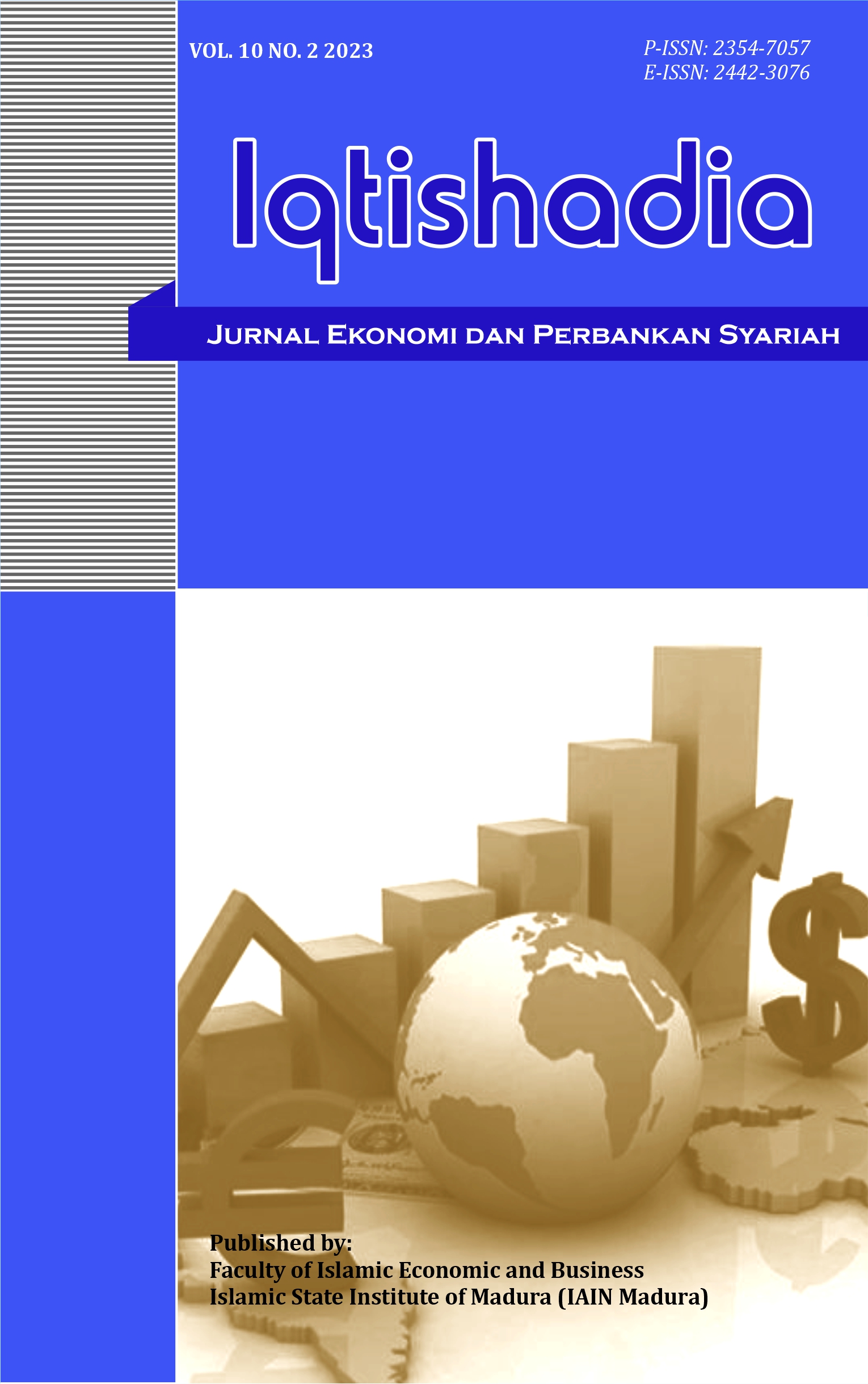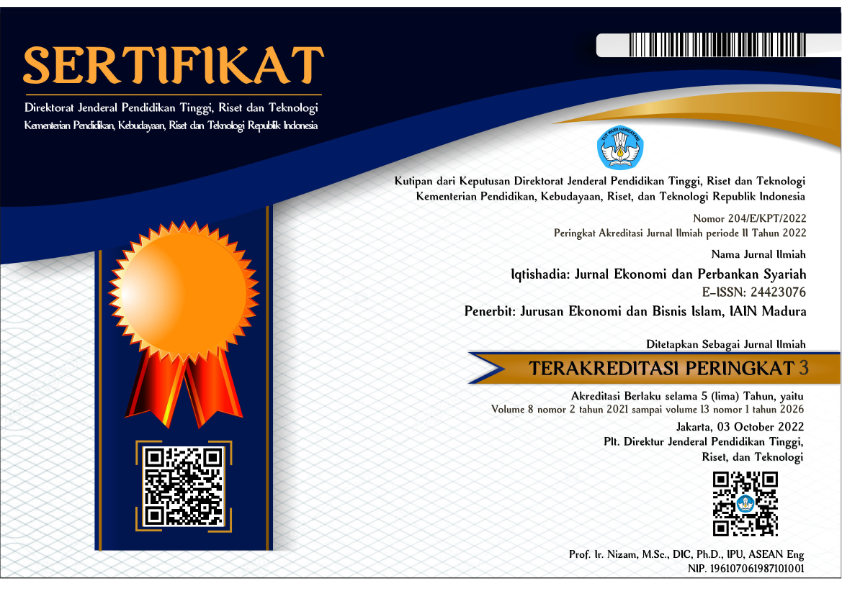Comparative Analysis of the Financial Performance of Bank NTB Syariah Before and After Conversion
 Abstract views: 328
,
Abstract views: 328
,
 pdf downloads: 441
pdf downloads: 441
Abstract
Bank NTB Syariah officially converted on 28 September 2018. The conversion had a positive impact but did not guarantee to improve the bank's financial performance after the conversion. The purpose of the study was to identify differences in the performance of financial ratios of liquidity, solvency, and profitability of Bank NTB Syariah before and after the conversion. Secondary data used from the financial statements of Bank NTB Syariah for the period of the third quarter of 2014 to the second quarter of 2022. Wilcoxon Signed Rank Test was used to identify whether there is a significant difference in the performance of financial ratios of Bank NTB Syariah before and after the conversion. The results obtained show that the NPF, CAR, ROA, ROE, BOPO and NOM ratios have significant differences before and after the conversion, while the FDR and DER ratios show no significant difference.
Downloads
References
Adha, Syamsul Idhu, Hafas Furqani, dan Muhammad Adnan. “Konversi Bank Konvensional Menjadi Bank Syariah di Indonesia.” Journal of Sharia Economics 1, no. 1 (2020).
Adnan, Muhammad Akhyar, Khasan Faozi, Zulhendra, dan M. Sopian Hadianto. Rasio Keuangan BKPH. Jakarta: Badan Pengelola Keuangan Haji, 2022. www.bpkh.go.id.
Alamsyah, Sustari, dan Sheily Dwi Meylida. “Analisis Perbandingan Kinerja Car, Roa, Nim, Bopo Dan Ldr Perbankan Syariah Dengan Perbankan Konvensional.” Balance Vocation Accounting Journal 4, no. 2 (2021): 137. doi:10.31000/bvaj.v4i2.4078.
Amalya, Neneng Tita. “Pengaruh Return on Asset, Return on Equity, Net Profit Margin Dan Debt To Equity Ratio Terhadap Harga Saham.” Jurnal SEKURITAS (Saham, Ekonomi, Keuangan dan Investasi) 1, no. 3 (2018): 157–81. doi:10.32493/skt.v1i3.1096.
Budianto, Budianto, dan Dara Angreka Soufyan. “Analisis Perbandingan Kinerja Keuangan Bank Aceh Sebelum dan Sesudah Konversi Syariah.” Jurnal Akademi Akuntansi 4, no. 2 (2021): 288–300. doi:10.22219/jaa.v4i2.18124.
Bukve, Oddbjørn. Designing Social Science Research. Cham, Switzerland: Palgrave Macmillan, 2019. doi:https://doi.org/10.1007/978-3-030-03979-0.
Demsar, Janez. “Statistical Comparisons of Classifiers over Multiple Data Sets.” Journal ofMachine Learning Research 7 (2006): 1–30.
Fahdiansyah, Restu. “Kinerja Keuangan Bank Sebelum dan Sesudah Konversi ke Bank Syariah (Studi Pada Bank NTB Syariah).” Jurnal Akuntansi dan Audit Syariah 2, no. 2 (2021): 123–35.
Syafia, Fairuz, and Ach Baiquni. “Implikasi Pendidikan, Pelatihan Dan Kepribadian Terhadap Kinerja Karyawan PT. BPRS Sarana Prima Mandiri Pamekasan.” Mabny : Journal of Sharia Management and Business 1, no. 01 (April 30, 2021): 79–104. https://doi.org/10.19105/mabny.v1i01.4635.
Hamza, Hichem. “Sharia governance in Islamic banks: effectiveness and supervision model.” International Journal of Islamic and Middle Eastern Finance and Management 6, no. 3 (2013): 226–37. doi:10.1108/IMEFM-02-2013-0021.
Ismanto, Deny, dan Dwi Keri Agung Laksono. “Analisis Perbandingan Kinerja Keuangan pada Bank Umum Syariah BUMN (Bank BRI Syariah, Bank Syariah Mandiri dan Bank BNI Syariah).” Jurnal Pasar Modal dan Bisnis 2, no. 2 (2020): 99–114. doi:10.37194/jpmb.v2i2.42.
Kasmir. Analisis Laporan Keuangan. Jakarta: PT Raja Grafindo Persada., 2014.
Kautsar, Sinathrya Al, Lusiana Indra, Taufan Prasojo Wicaksono S, dan Dewi Hanggraeni. “Pengaruh Konversi Bank Konvensional Menjadi Bank Syariah Terhadap Risiko Kebangkrutan Studi Kasus Pada Bank Aceh.” E-Jurnal Ekonomi dan Bisnis Universitas Udayana 8, no. 6 (2019): 550–66. doi:10.24843/eeb.2019.v08.i06.p02.
Kim, Tae Kyun. “T test as a parametric statistic.” Korean Journal of Anesthesiology 68, no. 6 (2015): 167–206. doi:10.4324/9781315686875-6.
Lestari, Dwi, Yuliawati, dan Faizatu Almas Hadyantari. “Faktor-Faktor Yang Mempengaruhi Non Performing Financing (Npf) Pada Bank Umum Syariah Di Indonesia.” Islamic Economics and Business Review 2, no. 1 (2023): 112–26.
Mester, Loretta J. “A study of bank efficiency taking into account risk-preferences.” Journal of Banking and Finance 20, no. 6 (1996): 1025–45. doi:10.1016/0378-4266(95)00047-X.
Nurbaiti, Nurbaiti, M Haykal, Iswadi Iswadi, dan Wahyuddin Wahyuddin. “Analisis Kinerja Keuangan Sesudah Dan Sebelum Konversi Unit Usaha Syariah Ke Bank Umum Syariah Pada PT Bank Aceh Syariah.” Jurnal Akuntansi Malikussaleh (JAM) 1, no. 1 (2022): 111. doi:10.29103/jam.v1i1.7446.
Ramdan, Andi Nurmansyah, Radyum Ikono, dan Putri Reno Kemala Sari. “Manajemen Proses Konversi Perbankan Konvensional Menjadi Perbankan Syariah Studi Kasus Bank Ntb Syariah.” Jurnal TAMBORA 4, no. 2A (2020): 1–9. doi:10.36761/jt.v4i2a.763.
Somantri, Yeni Fitriani, dan Wawan Sukmana. “Analisis Faktor- Faktor yang Mempengaruhi Financing to Deposit Ratio (FDR) pada Bank Umum Syariah di Indonesia.” Berkala Akuntansi dan Keuangan Indonesia 4, no. 2 (2019): 61–71. doi:10.20473/baki.v4i2.18404.
Sunyoto, Danang. Prosedur Uji Hipotesis untuk Riset Ekonomi. Bandung: Alfabeta, 2014.
Wardana, Guntur Kusuma, dan Fadlil Abdani. “BUKTI EFISIENSI BANK SYARIAH DI INDONESIA DAN MALAYSIA: ROA, BANK SIZE DAN NPF.” Jurnal Ilmiah Bisnis dan Ekonomi Asia 17, no. 1 (2023): 30–41. doi:10.32812/jibeka.v17i1.1026.
Zubair, Muhammad Kamal. “Akselerasi Pertumbuhan Bank Syariah di Indonesia.” Millah 8, no. 1 (2008): 1–16. doi:10.20885/millah.vol8.iss1.art1.
The journal operates an Open Access policy under a Creative Commons Non-Commercial Share-Alike license. All articles published Open Access will be immediately and permanently free for everyone to read and download.
• Creative Commons Attribution-NonCommercial (CC-BY-NC)

Iqtishadia: Jurnal Ekonomi dan Perbankan Syariah by http://ejournal.iainmadura.ac.id/index.php/iqtishadia is licensed under a Creative Commons Attribution-NonCommercial 4.0 International License.
Based on a work at http://ejournal.iainmadura.ac.id.


























